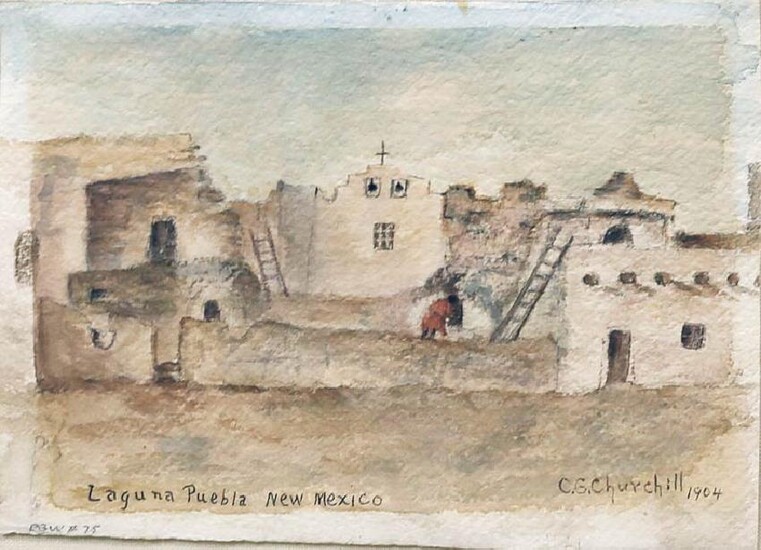Churchill Watercolor of Indian Territory
Churchhill, C. G. (Late 19th - Early 20th Century).
Laguna Puebla New Mexico.
Watercolor and pencil on paper.
Signed "C. G. Churchill" and dated "1904", l.R.
6 1/2” x 9 1/4” sheet, 15 1/2” x 18” framed.
This collection of evocative watercolors fully captures the somber and subtle beauty of Fort Gibson, Oklahoma. Though the fort is an important part of American military history, it is most famous (or infamous) for having been the “terminus” on the Trail of Tears. Prior to 1824, the government forcibly removed eastern tribes of Native Americans to the West. These striking watercolors, painted nearly a decade after Fort Gibson’s abandonment, serve as important visual records of life in nineteenth-century Indian Territory.
As mentioned previously, Fort Gibson also served an important function in the administration of Indian Territory. As such, a number of important tribal heads maintained residences at the fort. The home depicted in two of these four watercolors originally belonged to Chief Bushyhead, the twice-elected Principal Chief of the Cherokees beginning in August of 1879.
In spite of these watercolors’ beauties, life in Indian Territory was for the most part extremely arduous. Nevertheless, these compositions wonderfully convey the splendor of the Oklahoma landscape and offer us a rare, first-hand glimpse of one of the West’s most important military forts.
View it on
Estimate
Time, Location
Auction House
Churchhill, C. G. (Late 19th - Early 20th Century).
Laguna Puebla New Mexico.
Watercolor and pencil on paper.
Signed "C. G. Churchill" and dated "1904", l.R.
6 1/2” x 9 1/4” sheet, 15 1/2” x 18” framed.
This collection of evocative watercolors fully captures the somber and subtle beauty of Fort Gibson, Oklahoma. Though the fort is an important part of American military history, it is most famous (or infamous) for having been the “terminus” on the Trail of Tears. Prior to 1824, the government forcibly removed eastern tribes of Native Americans to the West. These striking watercolors, painted nearly a decade after Fort Gibson’s abandonment, serve as important visual records of life in nineteenth-century Indian Territory.
As mentioned previously, Fort Gibson also served an important function in the administration of Indian Territory. As such, a number of important tribal heads maintained residences at the fort. The home depicted in two of these four watercolors originally belonged to Chief Bushyhead, the twice-elected Principal Chief of the Cherokees beginning in August of 1879.
In spite of these watercolors’ beauties, life in Indian Territory was for the most part extremely arduous. Nevertheless, these compositions wonderfully convey the splendor of the Oklahoma landscape and offer us a rare, first-hand glimpse of one of the West’s most important military forts.



